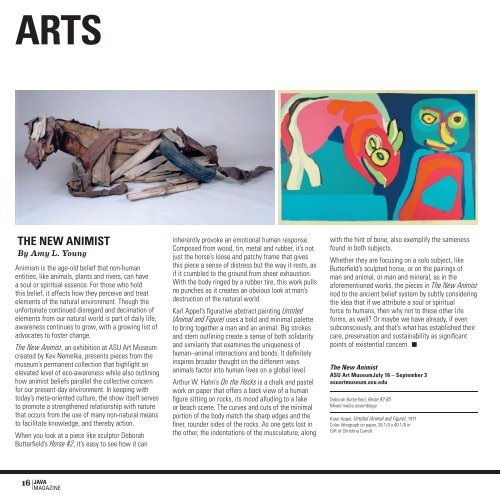Java.July.2016
You also want an ePaper? Increase the reach of your titles
YUMPU automatically turns print PDFs into web optimized ePapers that Google loves.
ARTS<br />
THE NEW ANIMIST<br />
By Amy L. Young<br />
Animism is the age-old belief that non-human<br />
entities, like animals, plants and rivers, can have<br />
a soul or spiritual essence. For those who hold<br />
this belief, it affects how they perceive and treat<br />
elements of the natural environment. Though the<br />
unfortunate continued disregard and decimation of<br />
elements from our natural world is part of daily life,<br />
awareness continues to grow, with a growing list of<br />
advocates to foster change.<br />
The New Animist, an exhibition at ASU Art Museum<br />
created by Kev Nemelka, presents pieces from the<br />
museum’s permanent collection that highlight an<br />
elevated level of eco-awareness while also outlining<br />
how animist beliefs parallel the collective concern<br />
for our present-day environment. In keeping with<br />
today’s meta-oriented culture, the show itself serves<br />
to promote a strengthened relationship with nature<br />
that occurs from the use of many non-natural means<br />
to facilitate knowledge, and thereby action.<br />
When you look at a piece like sculptor Deborah<br />
Butterfi eld’s Horse #2, it’s easy to see how it can<br />
inherently provoke an emotional human response.<br />
Composed from wood, tin, metal and rubber, it’s not<br />
just the horse’s loose and patchy frame that gives<br />
this piece a sense of distress but the way it rests, as<br />
if it crumbled to the ground from sheer exhaustion.<br />
With the body ringed by a rubber tire, this work pulls<br />
no punches as it creates an obvious look at man’s<br />
destruction of the natural world.<br />
Karl Appel’s figurative abstract painting Untitled<br />
(Animal and Figure) uses a bold and minimal palette<br />
to bring together a man and an animal. Big strokes<br />
and stern outlining create a sense of both solidarity<br />
and similarity that examines the uniqueness of<br />
human–animal interactions and bonds. It definitely<br />
inspires broader thought on the different ways<br />
animals factor into human lives on a global level.<br />
Arthur W. Hahn’s On the Rocks is a chalk and pastel<br />
work on paper that offers a back view of a human<br />
fi gure sitting on rocks, its mood alluding to a lake<br />
or beach scene. The curves and cuts of the minimal<br />
portion of the body match the sharp edges and the<br />
fi ner, rounder sides of the rocks. As one gets lost in<br />
the other, the indentations of the musculature, along<br />
with the hint of bone, also exemplify the sameness<br />
found in both subjects.<br />
Whether they are focusing on a solo subject, like<br />
Butterfi eld’s sculpted horse, or on the pairings of<br />
man and animal, or man and mineral, as in the<br />
aforementioned works, the pieces in The New Animist<br />
nod to the ancient belief system by subtly considering<br />
the idea that if we attribute a soul or spiritual<br />
force to humans, then why not to these other life<br />
forms, as well? Or maybe we have already, if even<br />
subconsciously, and that’s what has established their<br />
care, preservation and sustainability as significant<br />
points of existential concern.<br />
The New Animist<br />
ASU Art MuseumJuly 16 – September 3<br />
asuartmuseum.asu.edu<br />
Deborah Butterfield, Horse #2-85<br />
Mixed media assemblage<br />
Karel Appel, Untitled (Animal and Figure), 1971<br />
Color lithograph on paper, 26 1/4 x 40 1/8 in.<br />
Gift of Christina Carroll.<br />
16 JAVA<br />
MAGAZINE


















